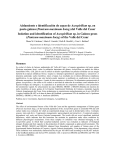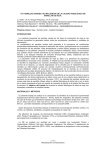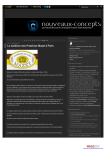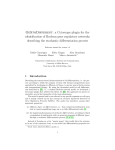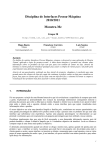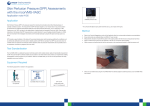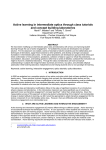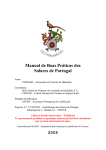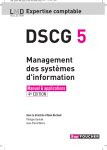Download Quality of persimmon fruit cv. Rojo brillante during storage at
Transcript
Spanish Journal of Agricultural Research (2004) 2 (2), 243-247 Quality of persimmon fruit cv. Rojo brillante during storage at different temperatures L. Arnal* and M. A. del Río Departamento de Postcosecha. Instituto Valenciano de Investigaciones Agrarias. Ctra. Moncada-Náquera, km 4.5. 46113 Moncada (Valencia). Spain Abstract Persimmon (Diospyros kaki L.) cv. Rojo brillante fruits were held at 1ºC, 8ºC and 15ºC (85-90% relative humidity), and evaluated after 13, 20, 27 and 34 days to study fruit quality changes during storage. Flesh firmness decreased and colour or acetaldehyde increased during storage. Fruit kept at 15ºC showed the highest total soluble solids and colour index values across most of the storage times. Fruit stored at 1ºC had the highest firmness. The greatest levels of acetaldehyde were found in fruit kept at 8ºC. A gradual increase of total soluble solid were detected in fruits kept at 1ºC. Key words: storage time, firmness, color index, acetaldehyde, soluble solids. Resumen Calidad de frutos de caqui cv. Rojo brillante durante el almacenamiento a diferentes temperaturas. Frutos de caqui (Diospyros kaki L.) cv. Rojo brillante fueron conservados a 1ºC, 8ºC y 15ºC (85-90% humedad relativa), y evaluados después de 13, 20, 27 y 34 días con la finalidad de estudiar los cambios en la calidad durante la conservación. Durante el almacenamiento la firmeza disminuyó, y el índice de color y el acetaldehído aumentaron. Los frutos conservados a 15ºC mostraron los mayores valores de sólidos solubles e índice de color, en la mayoría de los tiempos de almacenamiento. Los frutos conservados a 1ºC presentaron la mayor firmeza. Los niveles de acetaldehído más elevados se encontraron en frutos mantenidos a 8ºC. Se observó un incremento gradual en sólidos solubles totales en los frutos conservados a 1ºC. Palabras clave: tiempo de almacenamiento, firmeza, índice de color, acetaldehído, sólidos solubles. Introduction The rate of postharvest deterioration is affected by temperature (Wills et al., 1998). The rate of metabolism reactions within the physiological temperature range generally increases exponentially with an increase in temperature, however, in the case of climateric fruit, low temperatures can be used to delay ripening (Wills et al., 1998). Nevertheless, subtropical and tropical fruit are especially sensitive to chilling, and chilling injury (CI) is produced (Melvin, 1982). CI is the result of imbalanced metabolism and loss of cellular compartmentalization at suboptimal temperatures. This causes the release of metabolites from cells that, together with the degradation of cell structure, also provide an excellent substrate for the growth of pathogenic organisms, especially fungi. In addition, browning often * Corresponding author: [email protected] Received: 10-09-03; Accepted: 17-02-04. appears as a result of the enzyme polyphenol oxidase on phenolic compounds released from the vacuole after chilling. Another consequence of CI is the development of off-flavors or off-odors, with an accumulation of toxic products of metabolism, such as acetaldehyde (Wills et al., 1998). Decreasing fruit f irmness and color, increasing of ethylene production, or development of a gel-like consistency in the flesh are consequences of CI on some fruits (Woolf et al., 1997). The symptoms of CI normally occurs while the produce is at low temperature, but sometimes it will only appear when the produce is removed from chilling temperatures to higher temperatures (Wills et al., 1998). Persimmon fruit cultivar Rojo brillante is a climateric fruit. It is an astringent variety from subtropical zones, possessing excellent size and flavor. Sometimes fruit are stored too long at low temperatures before removing astringency. The removal of astringency is usually carried out in closed chambers with high concentration of carbon dioxide (92-98% CO2) from 244 L. Arnal and M. A. del Río / Span J Agric Res (2004) 2 (2), 243-247 20 to 24 h, at 20ºC. During cold storage reduction in flesh f irmness is a problem that impairs successful shipping and marketing. There is no information about how different storage times and temperatures affect this cultivar. The objective of this study was to evaluate the affect on quality of persimmon fruit Rojo brillante of different storage conditions for periods of up to 34 days. Material and Methods Fruit preparation and storage Persimmon fruit Rojo brillante were harvested when they were full orange colored while still firm and astringent, during 2000 season from a local grove in L’Alcudia (Valencia, Spain) and transported the same day to the experimental station, where fruit were sorted to eliminate obvious defects and then cooled overnight to 15ºC. Fruit were randomly divided into groups and stored at 1ºC, 8ºC or 15ºC (85-90% relative humidity). Fruit quality was assessed after 13, 20, 27, and 34 days of storage. Fruit quality assessment Flesh firmness was determined with a Texturometer Instron universal machine (model 4301, Instron Corp., Canton, Mass., USA) using an 8 mm plunger. Results were expressed as the load (kg) to break the flesh in each fruit on opposite sides after peel removal. Fruit firmness values are an average of 10 fruits per treatment. Skin colour was evaluated on samples of 20 fruit per treatment with a Minolta colorimeter (Model CR-300, Ramsey, NY, USA). Hunter parameters L, a, b were measured and results were expressed as skin colour index (Jiménez-Cuesta et al., 1981). Skin colour index = 1000a/Lb Sample preparation for biochemical analysis involved samples of 15 fruits per treatment divided into three replicates, where each fruit was cut in four longitudinal parts. Two of the opposite parts were placed in an electric juice extractor. Filtered juice was used to determine total soluble solids (TSS) and acetaldehyde content. The other opposite parts were sliced and frozen (–20ºC) to determine soluble tannins. TSS was measured twice from each replicate, with a digital refractometer (Atago, model PR1), and results were expressed as ºBrix. Acetaldehyde content was determined on three replicates of juice samples by headspace gas chromatography (Ke and Kader, 1990). Five ml of the filtered juice was transferred to 10 ml vials with crimp-top caps and sealed with teflon silicone. Samples were frozen (–20ºC) until analysis. For the analysis, the samples were put in a water bath at 20ºC for 1 h, followed by heating at 60ºC for 10 min. One ml sample of the headspace was withdrawn from the vials and injected into a gas chromatograph (PerkinElmer, model 2000, Norwalk, Conn., USA), provided with a flame ionization detector and 3.17 mm × 1.2 m Poropak QS 80/100 column. The injector, column and detector were set at 175ºC, 150ºC, and 200ºC respectively, and the carrier gas at 0.85 Bars. Acetaldehyde was identified and quantified by comparison of retention times with those of a standard solution and results were expressed as mg acetaldehyde in 100 ml of juice. Soluble tannins were evaluated using the FolinDenis method as described by Taira (1995). This colorimetric method is based on the reduction of Folin-Denis reagent by soluble tannins in alkaline solution. The calibration curve was made with gallic acid. Soluble tannins were assayed three times from frozen replicates. Five grams of the sample were placed directly into a solution of 25 ml of methanol 80%, and were homogenized with a high-shear probe mixer (Polytron, model PT 2100, Kinematica, AG Inc., Lucerne, Switzerland). Thereafter, samples were filtered and centrifuged at 14,000 rpm for 20 min at 4ºC and the supernatant was reserved. More supernatant was extracted from the precipitant with methanol 80% and added to the first supernatant. The total supernatant was brought to 100 ml with distilled water. One ml of this sample solution and 6 ml of distilled water were mixed and vortexed. Thereafter, 0.5 ml of 1N phenol reagent (Folin Ciacalteu reagent) were added and shaken well. After 3 min, 1 ml of saturated Na 2CO 3 was added, vortexed, and 1.5 ml of distilled water was added. Absorbance was measured after 1 h with a colorimeter (Perkin Elmer, Norwalk, Conn., USA) at 725 nm. Soluble tannins were expressed as ppm. External and internal quality of the fruit was also assessed visually by observing internal browning (IB) or external browning (EB). IB or EB were def ined as absent (none), slight (< 25% of the cut surface or total skin), medium (25-50% of the cut surface or total skin) or severe (> 50% of the cut surface or total skin). The IB and EB index were calculated for sample of 15 fruit per treatment as follows (Ben Arie et al., 1991): Main IB or EB index (0-10) = = (no. without browning x 0) + ( no. with slight browning × 2.5) + (no. with medium browning × 5) + + (no. with severe browning × 10)/15 245 35 30 25 20 15 10 5 0 0 10 20 Storage time (days) 30 1 ºC 15 ºC 8 ºC 40 Figure 2. Effect of temperature storage on colour index (1000a/Lb) of persimmon fruit cv. Rojo brillante. Error bars indicate standard deviations. Statistical analysis All data from determinations were subjected to analysis of variance (ANOVA), using Statgraphics 2.1 (Manugistics, Inc., Rockville, Md., USA). Results Fruit quality assessment at harvest Freshly harvested persimmon fruits were characterised by high firmness, low acetaldehyde content and high soluble tannin content, indicating their high astringency. Neither internal nor external browning or other visual damage was found. Fruit quality assessment after storage The effect of temperature on firmness during storage is shown on Fig. 1. Measurements of firmness showed a decrease through storage time at all temperatures, however, the specific behaviour depended on storage temperature. After 13 d of storage, a sharp decrease in firmness was observed for fruits stored at 8 and 15ºC. However, persimmon fruits stored at 1ºC maintained firmness up to 20 d of storage, and a decrease was observed after 34 d of storage. The colour index increased with storage time and temperature (Fig. 2). Fruit stored at 8ºC or 15ºC for 13 d exhibited an increase in colour index as compared to freshly-harvested fruit, whereas fruit stored at 1ºC maintained its initial colour for more time. TSS of fruits stored at 1ºC increased continuously through storage time (Fig. 3). Fruit stored for 13 days at 1ºC or 8ºC had a similar TSS to freshly harvested fruits, but higher values were observed in fruit kept at 15ºC. TSS of fruit stored at 15ºC increased from the first to the second storage period, but remained steady through the rest of storage time. Different behaviour was observed in fruit stored at 8ºC, since 5 20 4 19 TSS (ºBrix) Firmness (kg) Colour index (1000a/Lb) Quality during storage of persimmon 3 2 1 18 17 16 0 0 10 20 Storage time (days) 1 ºC 8 ºC 30 40 15 ºC Figure 1. Effect of temperature storage on firmness (kg) of persimmon fruit cv. Rojo brillante. Error bars indicate standard deviations. 15 0 10 20 Storage time (days) 1 ºC 8 ºC 30 40 15 ºC Figure 3. Effect of temperature storage in TSS (°Brix) of persimmon fruit cv. Rojo brillante. Error bars indicate standard deviations. Acetaldehyde (mg/100 ml) 246 L. Arnal and M. A. del Río / Span J Agric Res (2004) 2 (2), 243-247 3 Discussion 2,5 2 1,5 1 0,5 0 0 10 20 30 Storage time (days) 1 ºC 8 ºC 40 15 ºC Figure 4. Effect of temperature storage on acetaldehyde production (mg/100 ml) of persimmon fruit cv. Rojo brillante. Error bars indicate standard deviations. Soluble tannins (ppm) TSS values increased and decreased through storage time. Storage time affected acetaldehyde content since a general increase was observed over time (Fig. 4). However, the rate of increase depended on storage temperature. Acetaldehyde content increased after harvest, although for fruit stored at 1ºC acetaldehyde content did not increase until the last storage time. Acetaldehyde build-up was temperature dependent. The greatest increase corresponded to fruits stored at 8ºC. Fruits stored at 15ºC showed intermediate behaviour. Freshly harvested fruit showed a high level of soluble tannins responsible for their astringency (Fig. 5). Fruit astringency declined during storage. No IB or EB were detected on persimmon fruit. During storage, signs of other damages were monitored, such as growth of pathogenic organisms, and chilling injury development shown as gel-like consistency, abnormal softening, and development of internal cavities (Woolf et al., 1997; Wills et al., 1998). 700 600 500 400 300 200 100 0 0 10 20 Storage time (days) 1 ºC 8 ºC 30 40 15 ºC Figure 5. Effect of temperature storage on soluble tannins (ppm) of persimmon fruit cv. Rojo brillante. Error bars indicate standard deviations. Increase of temperature or storage time reduced firmness and increased the colour index of the fruit. Monzini and Gorini (1982) also confirmed that firmness of persimmon fruit decreases during storage, and similar results in firmness of other fruit were found by other authors (Johnston et al., 2001; Grochowicz et al., 2001). Ragazzini (1985) showed that colour evolution depends on storage temperature. The effect of storage temperature on the colour of citrus was studied by Tatsumi (2000), who confirmed that the peel colour changed when fruits were stored at temperatures above 10ºC. The higher values in TSS at 15ºC is a good indication that ripening of the fruit has been accelerated by temperature. However, after 34 days storage at 1 or 15ºC similar values in TSS were achieved in fruit, but the rate of increase depended on storage temperature. Prolonged storage usually produces an accumulation and increase in volatile content of fruit (MartínezJávega et al., 1991; Graell et al, 2001). In these experiments, storage time affected acetaldehyde content since a general increase was observed with time. There was not a relation between increasing acetaldehyde content and temperature increase, since the greatest values were found in fruits stored at 8ºC, followed by fruits stored at 15 and 1ºC. Fruit astringency declined during storage. This is not surprising in view of previous reports showed a decrease in fruit astringency as fruit ripened (Ragazzini, 1985; Herrero and Guardia, 1992). In general, our experiment showed a decrease in soluble tannins with an increase in acetaldehyde production. Arnal and Del Río (2003) reported that there was a relation between astringency removal and acetaldehyde content, since soluble tannins become insoluble, mainly because of the polymerization or condensation with acetaldehyde. After 34 days of storage, the levels of acetaldehyde produced by fruits stored at different temperatures were correlated with small differences in soluble tannins. Some authors have shown that symptoms of CI normally occurs while the produce is at low temperature but sometimes will only appear when the produce is removed from chilling temperature to a higher temperature (Collins and Tisdell, 1995; Wills et al., 1998). In our experiments, no visual damage or CI was observed. Perhaps this was due to the fact that persimmon fruits were not transferred to a higher temperature after cold storage. Quality during storage of persimmon As conclusions, flesh firmness, acetaldehyde, colour index, TSS and soluble tannins showed some changes with storage time and temperature. Persimmon fruit Rojo brillante stored at 1ºC maintained higher firmness, and lower skin colour index than fruit stored at 8 or 15ºC, but no significant differences in firmness were found after 34 days storage. In addition, this storage temperature did not increase acetaldehyde levels to the same extent as those caused by storage at 8ºC and 15ºC storage. More research will be required to identify the response of stored persimmons to highCO 2 atmospheres in order to be exploited commercially. Nevertheless, the response to time-temperatures arrays will provide a useful tool for improving subsequent market handling. Acknowledgements Thanks to Instituto Valenciano de Investigaciones Agrarias (Moncada, Valencia, Spain) for the finantial support, to Cooperativa Ntra. Sra del Oreto (L’Alcudia, Valencia, Spain) for providing persimmon fruits cv. Rojo brillante, and to Dr Pérez-Gago (Postharvest Department, Instituto Valenciano de Investigaciones Agrarias) for valuable comments on this manuscript. References ARNAL L., DEL RÍO M.A., 2003. Removing astringency by carbon dioxide and nitrogen-enriched atmospheres in persimmon fruit cv. Rojo brillante. J Food Sci 68 (4), 1516-1518. BEN ARIE R., ZUTKHI Y., SONEGO L., KLEIN J., 1991. Modified atmosphere packaging for long-term storage of astringent persimmons. Postharvest Biol Tec 1, 169-179. COLLINS R.J., TISDELL J.S., 1995. The influence of storage time and temperature on chilling injury in ‘Fuyu’ and ‘Suruga’ persimmon (Diospyros kaki L.) grown in subtropical Australia. Postharvest Biol Tec 6, 149-157. GRAELL J., ECHEVERRÍA G., LÓPEZ M.L., 2001. Evolución de la calidad y de la producción aromática de man- 247 zanas ‘Fuji’ durante su conservación frigoríf ica. Acta Horticulturae 36, 438-446. GROCHOWICZ J., NADULSKI R., SHMULEVICH I., GALILI I., SEGINER J., BAILEY B., GIELING T., 2001. The impact of temperature on the mechanical properties of selected varieties of apples. Acta Horticulturae 562, 209-212. HERRERO A., GUARDIA J., 1992. Evolución de los frutos. In: Conservación de frutos, Manual técnico. Ed Mundi Prensa, Madrid, Spain. pp. 85-92. JIMÉNEZ-CUESTA M., CUQUERELLA J., MARTÍNEZJÁVEGA J.M., 1981. Determination of a color index for citrus fruit degreening. Proc Int Soc Citriculture 2, 750-753. JOHNSTON J.W., HEWETT E.W., HERTOG M.L.A.T.M., HARKER F.R., 2001. Temperature induces differential softening responses in apple cultivars. Postharvest Biol Tec 23, 185-196. KE D., KADER A., 1990. Tolerance of ‘Valencia’ oranges to controlled atmospheres as determined by physiological responses and quality attributes. J Am Soc Hortic Sci 115, 779-783. MARTÍNEZ-JÁVEGA J.M., MATEOS M., NAVARRO P., 1991. Influencia de la temperatura de conservación y condiciones de almacenamiento en la calidad final de la mandarina Nova. Abstr Book III Congreso Mundial de Tecnología de Alimentos, Barcelona, Spain, Feb 20-23, p. 62. MELVIN H., 1982. Chilling injury of crops of tropical and subtropical origin. HortScience 17, 162-165. MONZINI, A., GORINI F., 1982. Raccolta, conservazione e utilizzazione industriale. In: Frutticoltura anni 80, Il kaki (E. Baldini, F. Scaramuzzi, eds.) Reda Press, Italy. pp 103-119. RAGAZZINI D., 1985. Caracteres culturales. In: El kaki. 3th ed., Ed Mundi Prensa, Madrid, Spain. pp. 59-132. TAIRA S. 1995. Astringency in persimmon. In: Fruit analysis (Linskens HF, Jackson JF, eds.). Springer, Germany. pp. 97-110. TATSUMI Y. 2000. Studies on the storage of Hebezu fruits. Bulletin of the Faculty of Agriculture, Miyazaki University 47, 59-68. WILLS R., MCGLASSON B., GRAHAM D. JOYCE D. 1998. Effects of temperature. In: Postharvest. 4th ed., UNSW Press, Australia pp. 60-76. WOOLF A.B., BALL S., SPOONER K.J., LAY-YEE, M., FERGUSON I.B., WATKINS C.B., GUNSON A., FORBES S.K., 1997. Reduction of chilling injury in the sweet persimmon ‘Fuyu’ during storage by dry air heat treatments. Postharvest Biol Tec 11(3), 155-164.








